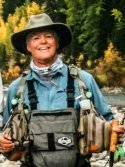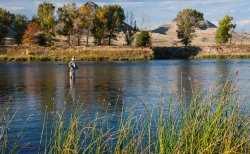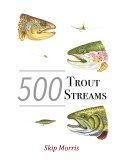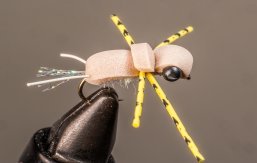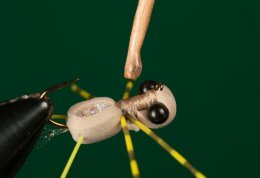Fly Fishing Wild Western Washington:
Outlands
by Skip Morris
(photos and captions by Carol Ann Morris)
*click on any image in this article to enlarge it, and
to see all photos in sequence*
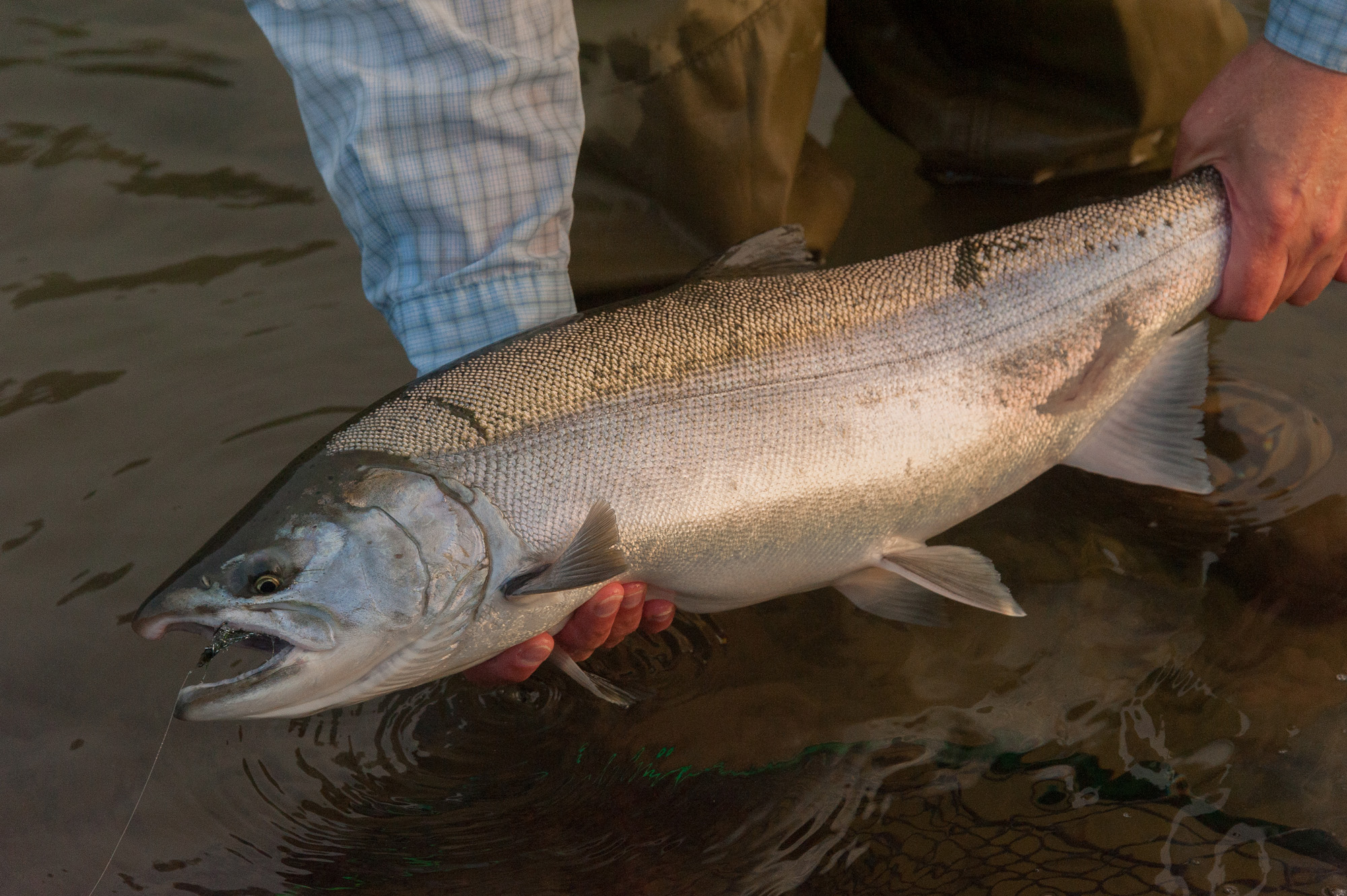 The beautiful chrome of a large silver salmon
The beautiful chrome of a large silver salmon
glowing gold from a breaking sunrise. Caught by Skip while fishing
western Washington with guide Jim Kerr.
Photo © Carol Ann Morris
I doubt there are many areas in the lower 48 states so thinly populated as the west side of Washington's Olympic Peninsula. I mean, the metropolis of the West Side, Forks, has lured in or managed to hold onto a total of only around 3,500 persons who can handle the 120 or so inches of rain that hammer them over the course of an average year. Strange. . .
Hmmm, I wonder, why only 3,500?
Land of the Undead (and the Hairy)
If you don't happen to live in Sekiu or Joyce or one of the few other much smaller (honest!) towns within 50 miles of Forks yet have heard of Forks, then that's probably because you're familiar with the Twilight vampire/werewolf craze whipped up by a series of books and movies set in that soggy hamlet. Or else you yourself are a vampire or werewolf with a sense of community who consequently keeps up on group-related news, such as rain-soaked little bergs where your sort gathers.
Outside of Forks, it gets primitive fast. The Olympic Mountains, rivers running uncorrupted through federally protected primeval forest, surf, and magnificent beaches with amazing rock formations, all—and this is a particularly apt use of the word—pristine. On second thought, joking aside, I really do wonder why only 3,500. . . Though I'm pleased about it; wouldn't be the West Side anymore if humans swarmed it.
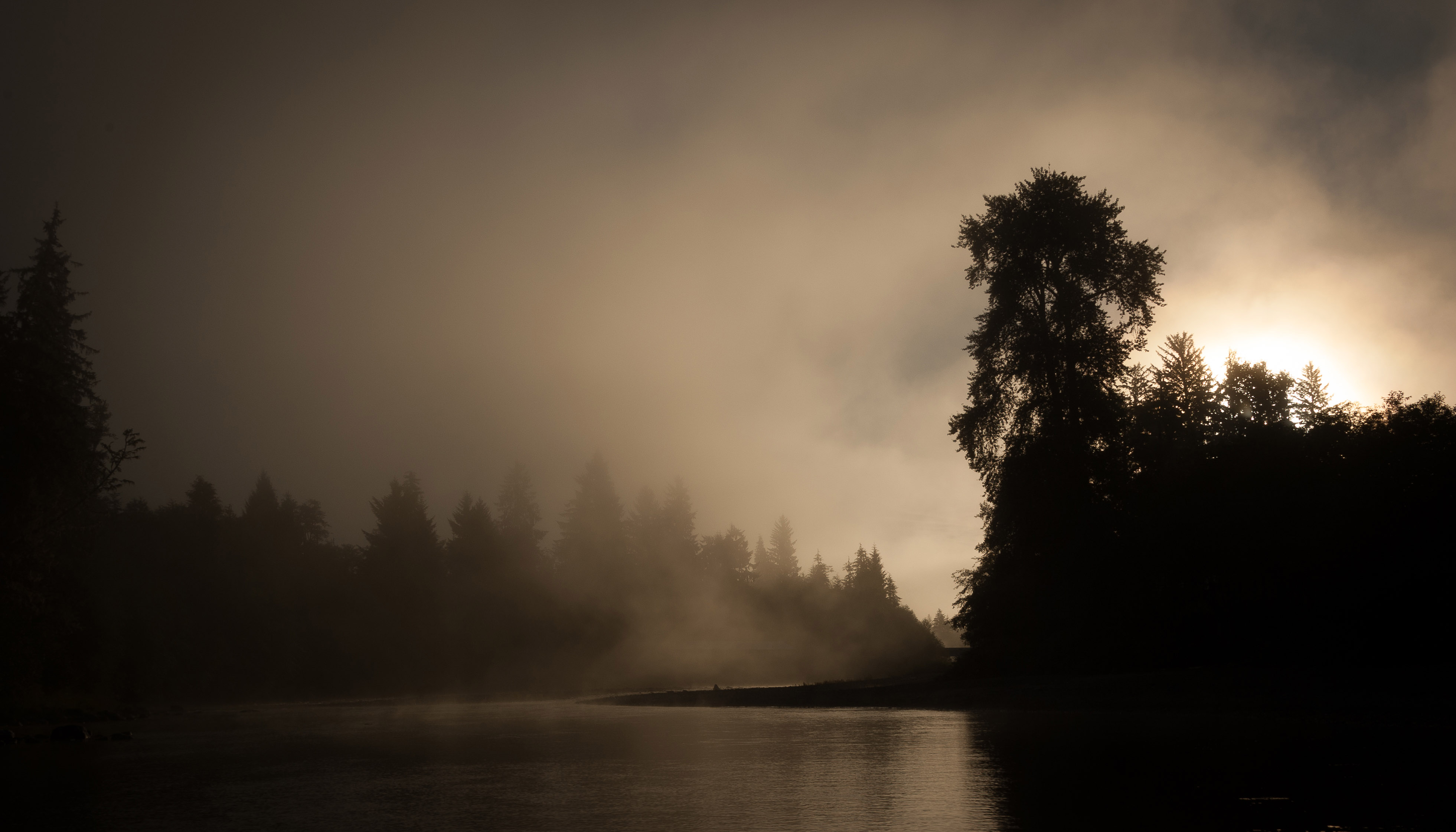 Early morning sun breaking through the fog on Washington's wild westside.
Early morning sun breaking through the fog on Washington's wild westside.
Photo © Carol Ann Morris
One More Reason to Go West
Despite that gloomy rainfall stat I mentioned, west-side summers can be warm and dry among all that greenery and ocean and pure fresh water. And summer is when we joined our fly-fishing guide friend Jim Kerr for what he calls—in perfect concision—his "summer fishing."
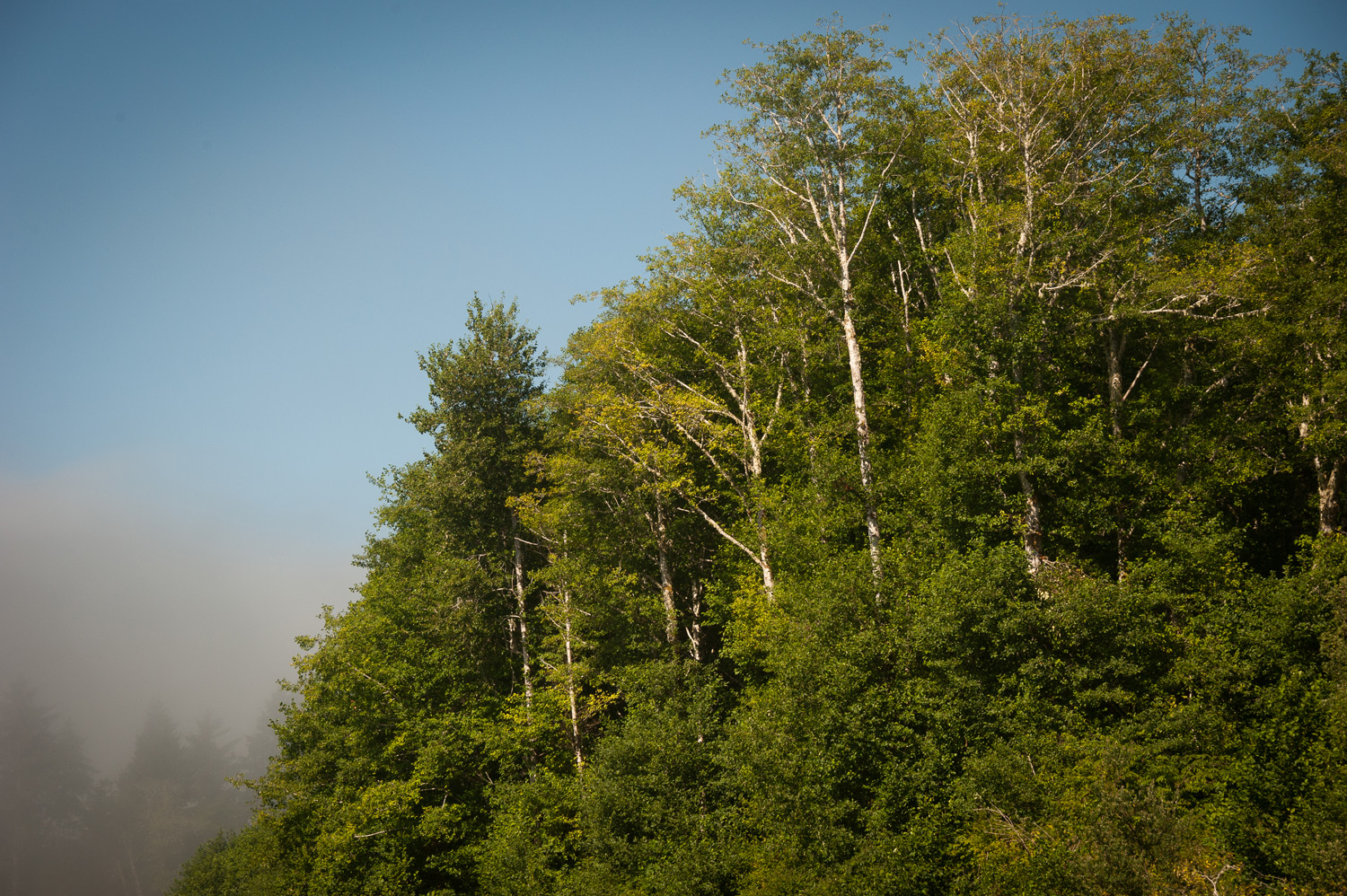 Lush forests line the rugged rivers of western
Lush forests line the rugged rivers of western
Washington state.
Photo © Carol Ann Morris
Jim guides often for salmon and steelhead, but less often for the fascinating sea-run cutthroat trout that run to west-side rivers and creeks. Oddly, with as many sea-run fanatics as there are in Western Washington, few seem willing to drive a few hours to the ocean side of the Peninsula to go out after these hard, fiery, and intriguing sport fish with Jim.
But my wife, Carol Ann, and I hesitated not a moment to say Yes to Jim's invitation to do just that.
The Driest of the Dry
It's been a horrid year for water in Washington—the worst—rarely a sprinkle of rain, and plain hot. Crossing the Sol Duc River a few times on our drive out, Carol and I looked down from bridges to see a lazing shallow flow surely too warm to please trout and salmon, with much of its structure of boulders and gravel bars baked white in air and sunshine. And it was still only July. So, to protect the fish we caught under such dire conditions, Jim took us to the tidal stretch of a big river where the ocean provided the fish plenty of cool water. And, he took us early, when the river was as cool as it would get. We met at 5:00am the first morning, Carol and I staggering in a daze. But we soon snapped out of that.
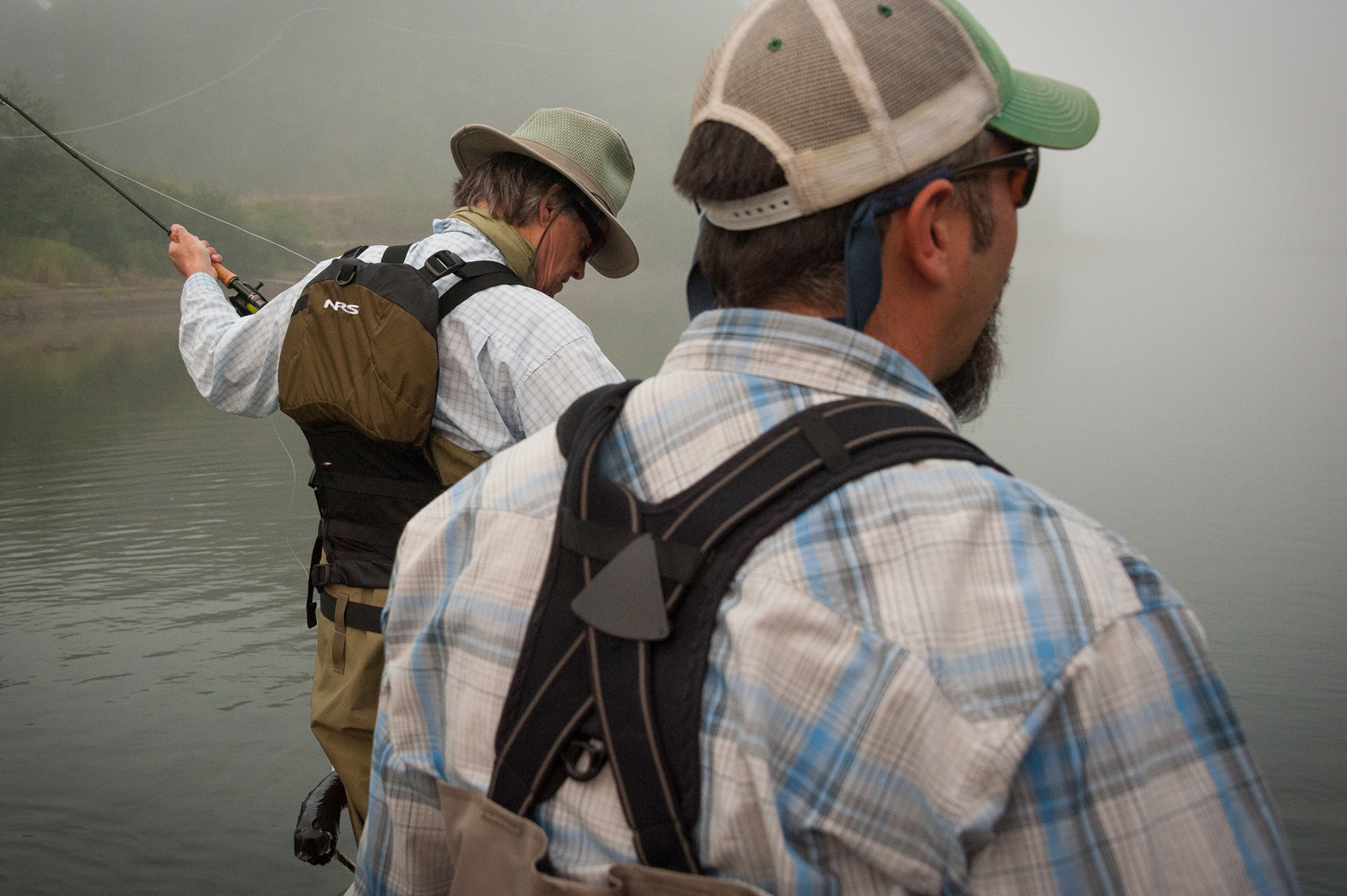 Skip readying the rod to fish for silvers in the early morning fog on Washington state's primitive Olympic Peninsula—with fly fishing guide Jim Kerr, owner/operator of Raincoast Guides, looking on.
Skip readying the rod to fish for silvers in the early morning fog on Washington state's primitive Olympic Peninsula—with fly fishing guide Jim Kerr, owner/operator of Raincoast Guides, looking on.
Photo © Carol Ann Morris
On to the Fishing...
With the sun still hidden well below the horizon, we sat in Jim's river raft anchored across from a deep slot in the half-dark. The tide wasn't yet swelling the pool so we were, at least temporarily, in river and not estuary. Jim explained the strategy, a detailed one that essentially amounted to casting well out among the swirling salmon, letting the fly sink to a certain level, and then drawing it so that it showed itself to fish in a particular way. It worked, of course—we know Jim, so we know to trust his instructions and follow them. I grabbed my rod with the specific sinking line Jim had recommended I bring, and tied on some heavy tippet and an insanely bright Morris Minnow. (All Morris Minnows are insanely bright, and they often catch me big trout and more. For example, read on. . .)
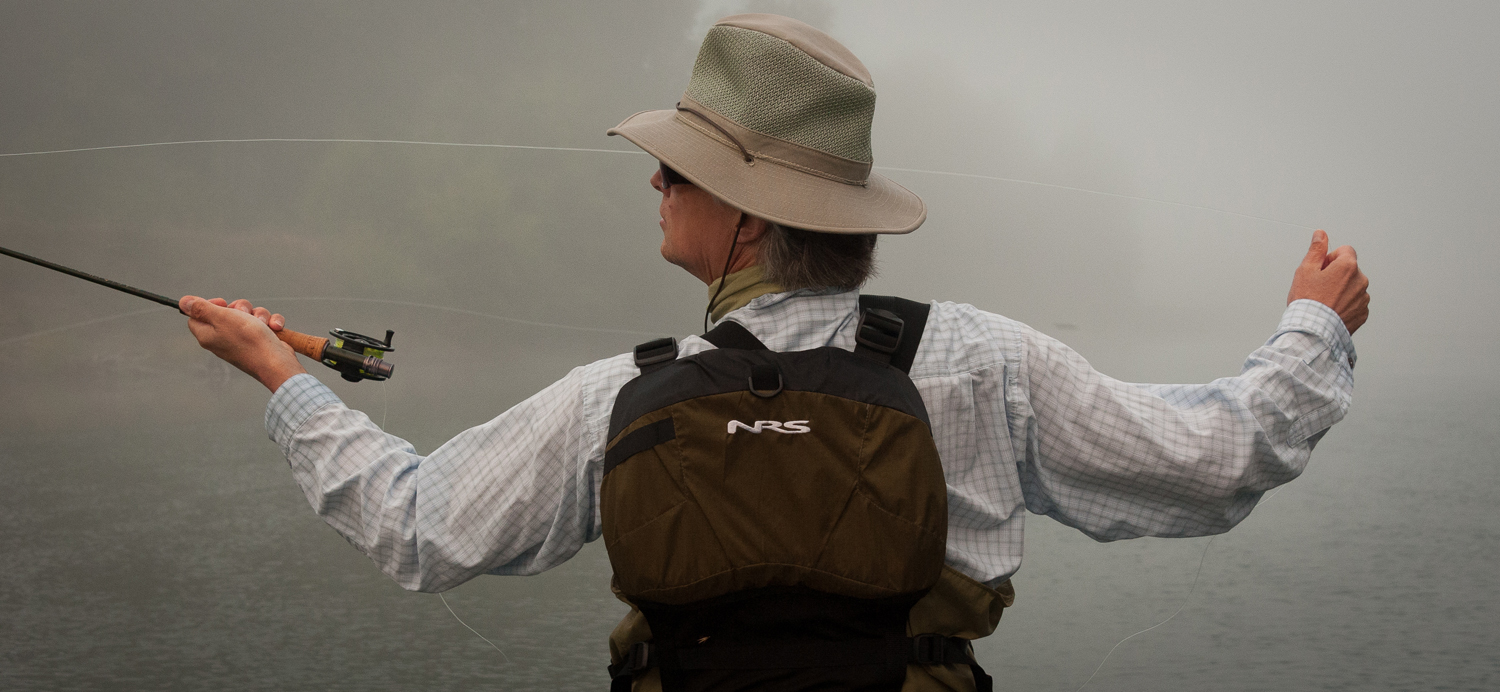 Skip casting through the fog
Skip casting through the fog
in the hope of hooking into a big silver.
Photo © Carol Ann Morris
Only five or ten minutes into our fishing the first fish took my fly—or, more accurately, simply stopped it. I struck, and found myself fast to a salmon that was coming in far too lazily. Suddenly it became clear that I hadn't yet sufficiently annoyed the big fish. He flew up and out in a rage. From there it was a game of keeping the line clear and jerking my hand clear of the reel whenever he got the urge to sail off again on another fine run. I'd brought a large reel loaded with backing. He showed me at least 100 feet of it.
In the net, we guessed him at around ten pounds, the brightest silver a silver salmon could display, so fresh he was probably down swimming among jellyfish the day before.
It went on this way through two more salmon and three failed salmon hook-ups. That's when Carol decided to trade camera for rod. The sun was throwing its first glare on the water when she started, and Jim said that that would only make things tougher.
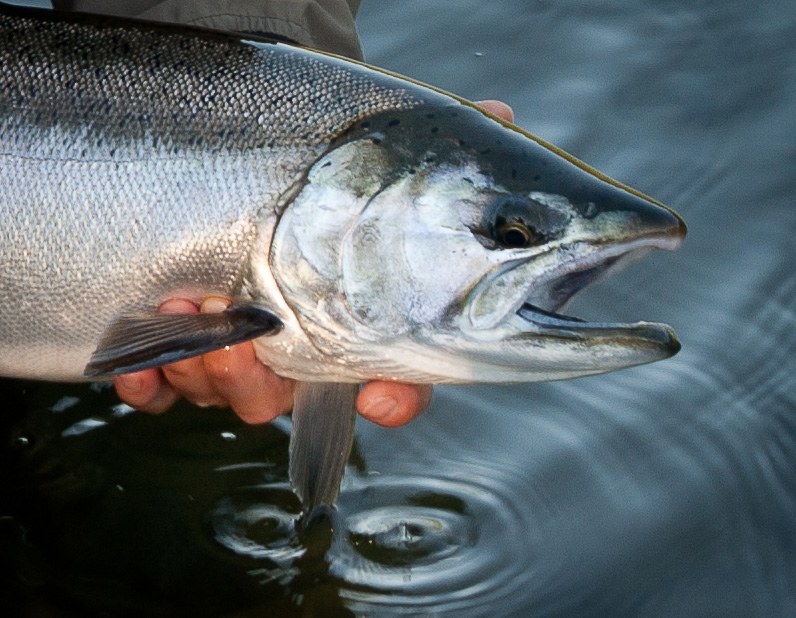 A beautiful silver salmon from the
A beautiful silver salmon from the
wild waters of Washington's westside.
Photo © Skip Morris
But Carol had decided she was going to hook a silver, and only a fish that's a fool takes lightly the determination and instincts of veterinarian Carol. She bent in concentration, trained her gaze on the gray depths of the slot. The sun continued its climb to wash the pool in angled sunlight ever stronger and make a hook-up ever more unlikely.
Then Carol let out one of her whoops, a sound I've loved from the first time I heard it (about 25 years ago) back when she hooked her very first fish on a fly. Another shining salmon took off and her reel was howling in alarm; actually, so was Carol (she's naturally a quiet fisherman. . .until she hooks a good fish). A few runs later it lay in the net, six pounds of stout chrome. Moments after that it was slipping back into the river, winded, but with no more than a dentist's stab in the gums to show for its troubles.
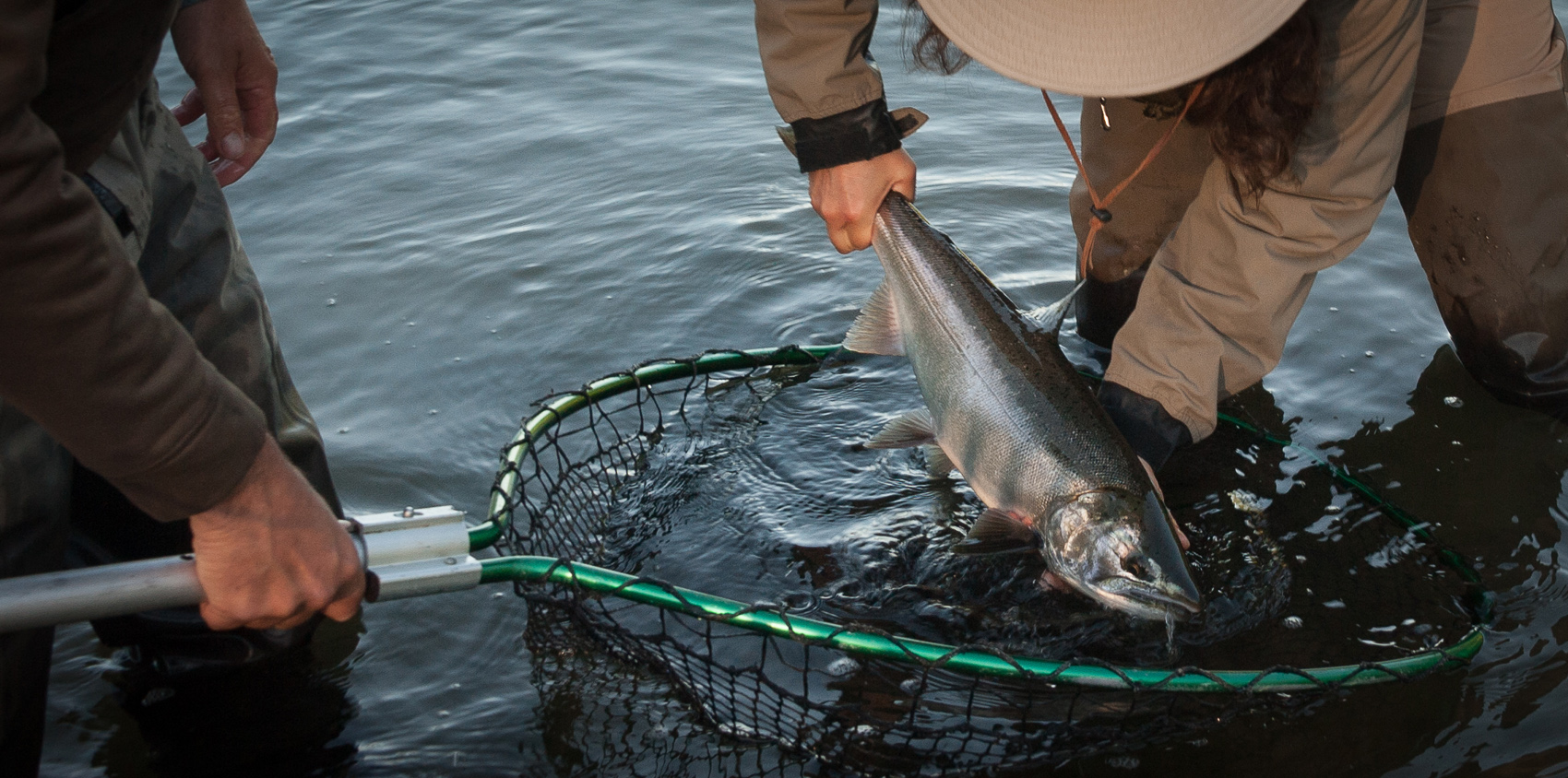 Carol's catch—a bright silver salmon brought
Carol's catch—a bright silver salmon brought
to the net, and ready to be released.
Photo © Skip Morris
The rest of the day we chased sea-runs, caught some, saw flounder we never hooked up in pools that still were pools, before the tide had opened them up, and generally had a fine day. Or, half-day; we quit around 1:00.
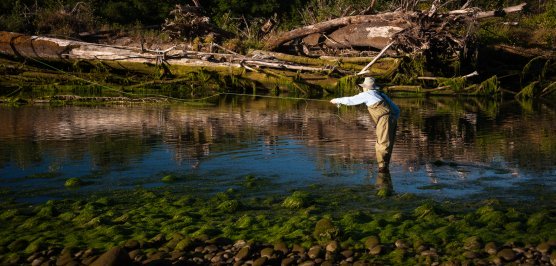 Skip fishing a tidal pool for searun cutthroats
Skip fishing a tidal pool for searun cutthroats
on Washington's rugged Olympic Peninsula.
Photo © Carol Ann Morris
The Great Pacific
Just before we left the water, Jim rowed us around a corner of steep tree-shaggy banks to reveal the Pacific Ocean, framed on its sides by steep, tree-shaggy hillsides, and seeming to fade off into infinity. The white layers of the surf, the broad beach, a rock island rising in mist. . . What a final scene of the day.
Briiiing—Will Somebody Kill that Alarm Clock!
Next morning, up early again, we were off to the same tidewater section of the river. We launched; then Jim rowed upstream and pulled the boat ashore. He said it was worth a few casts to walk up to a pool carpeted with the kind of yellow-green vegetation I'd grown up seeing on Puget Sound beaches, and it lay slick all over the gravel bar edging the pool too. Other than that, and the high stack of driftwood on the far side, it could have been reckoned a fairly classic trout pool. We cast, worked our flies, nothing. We moved up to the next pool to fish the tail-out. Again nothing.
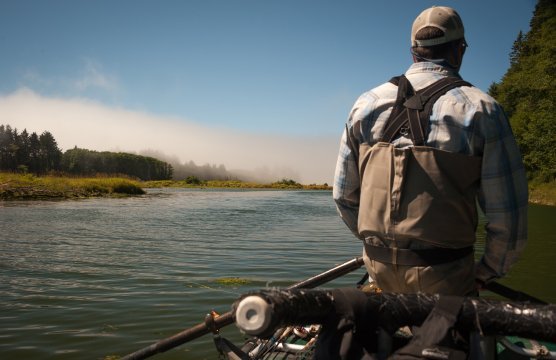 Fly fishing guide Jim Kerr, owner/operator of Rain Coast Guides,
Fly fishing guide Jim Kerr, owner/operator of Rain Coast Guides,
navigating western Washington's tidewaters.
Photo © Carol Ann Morris
Then. . .
So we walked back downstream to where the low tide left a good chop of current from the pool to what was currently the river's mouth. All through the current were sea-runs. I hooked plenty, lost some, landed some, on a smaller Morris Minnow. Carol twitched a dry fly, I think. . . Anyway, she hooked, landed, and lost her share too.
Once the chop had given us all it could, Jim dragged his raft upstream and over the thin lip of the pool. Carol and I climbed into the high, comfortable seats at the raft's ends. The pool just went and went, on upstream, and we teased at sea-runs that weren't there by twitching dry flies. Eventually, we found a trout or two, but we switched to streamers anyway, confident they'd improve our odds. Fishing remained slow until we came to a shallow edge that didn't look like much, and Jim stopped the raft. We said nothing—again, we knew to trust Jim.
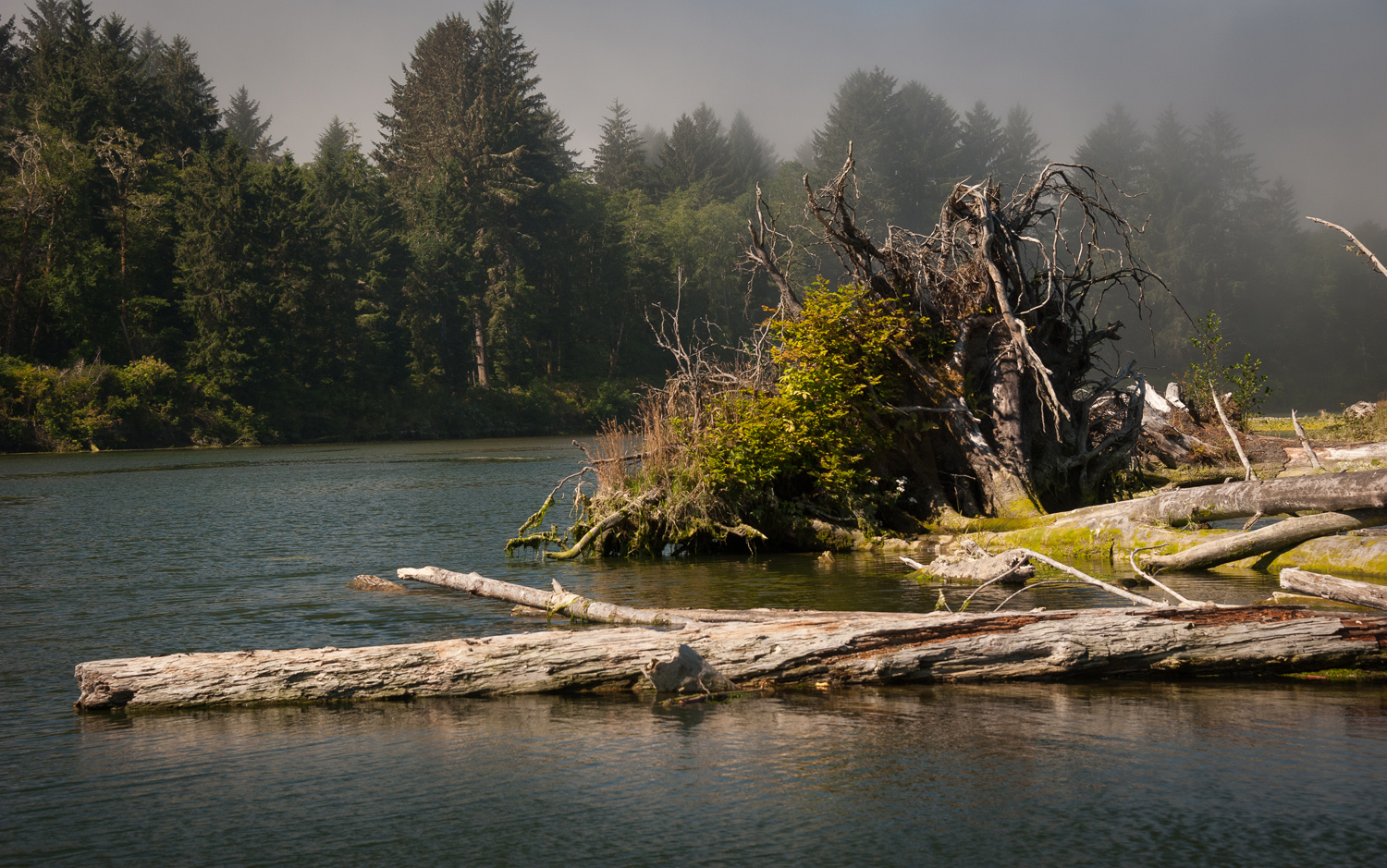 Late morning fog on the tidewaters of western Washington.
Late morning fog on the tidewaters of western Washington.
Photo © Carol Ann Morris
The low water was very clear, and back where it was too shallow for any sane trout to hold, we watched one slide smoothly out to grab one of our flies. After that it was good, steady sea-run fishing—and fascinating, with everything in full view like that.
Godzilla Trout, or So It Seemed
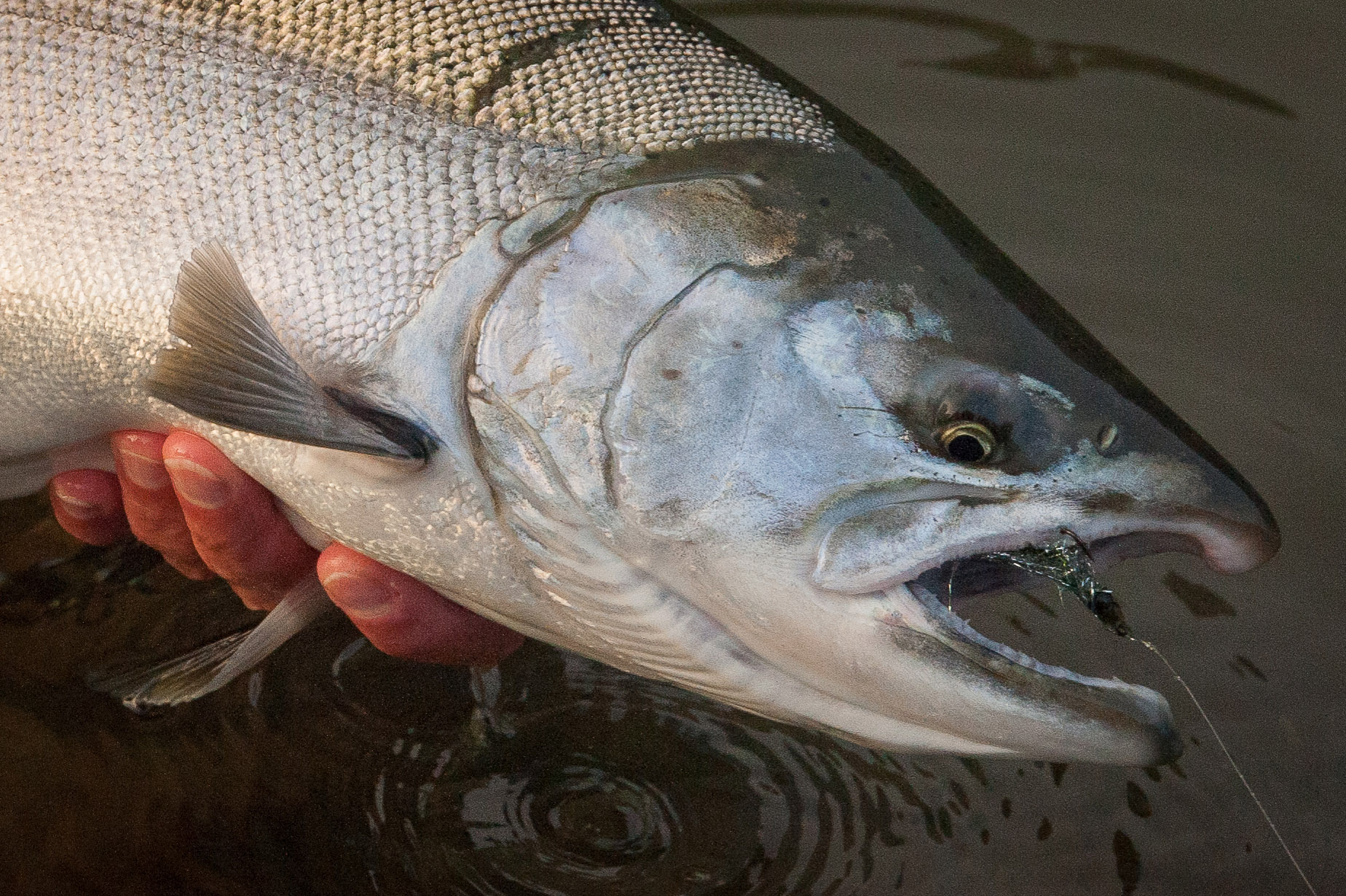 Striking silver on Washington's wild westside.
Striking silver on Washington's wild westside.
Photo © Carol Ann Morris
In one shallow spot nearly as still as a pond, a huge sea-run appeared behind my fly, moving fast. I remained calm—or close enough to calm—to let the fish close around my Reverse Spider before I tightened on him. It was the perfect situation for me to overreact and snap even my 2X tippet, and I knew it, so I spoke to myself: "Relax, take your time, it's just another fish. . ." But it certainly wasn't just another fish.
It wasn't a monster sea-run either. It was another silver salmon, as shiny bright and wild-fighting as the others. Sure, my hopes of landing my biggest sea-run yet were dashed, but I couldn't find a way to be disappointed.
Another World
There was more good sea-run fishing during our float downstream; then we hit the full effect of the tide—our green, driftwood trout pool was buried under water, as was everything else we'd left. The driftwood heap standing high up on the side of our former trout pool lay half submerged. This whole stretch was entirely new water to me and Carol now. And just to prove it, a swarm of herring—a few hundred of them at the very least—swung by Jim's raft. Welcome to Northwest tides—they transform everything around here that touches saltwater once or twice a day.
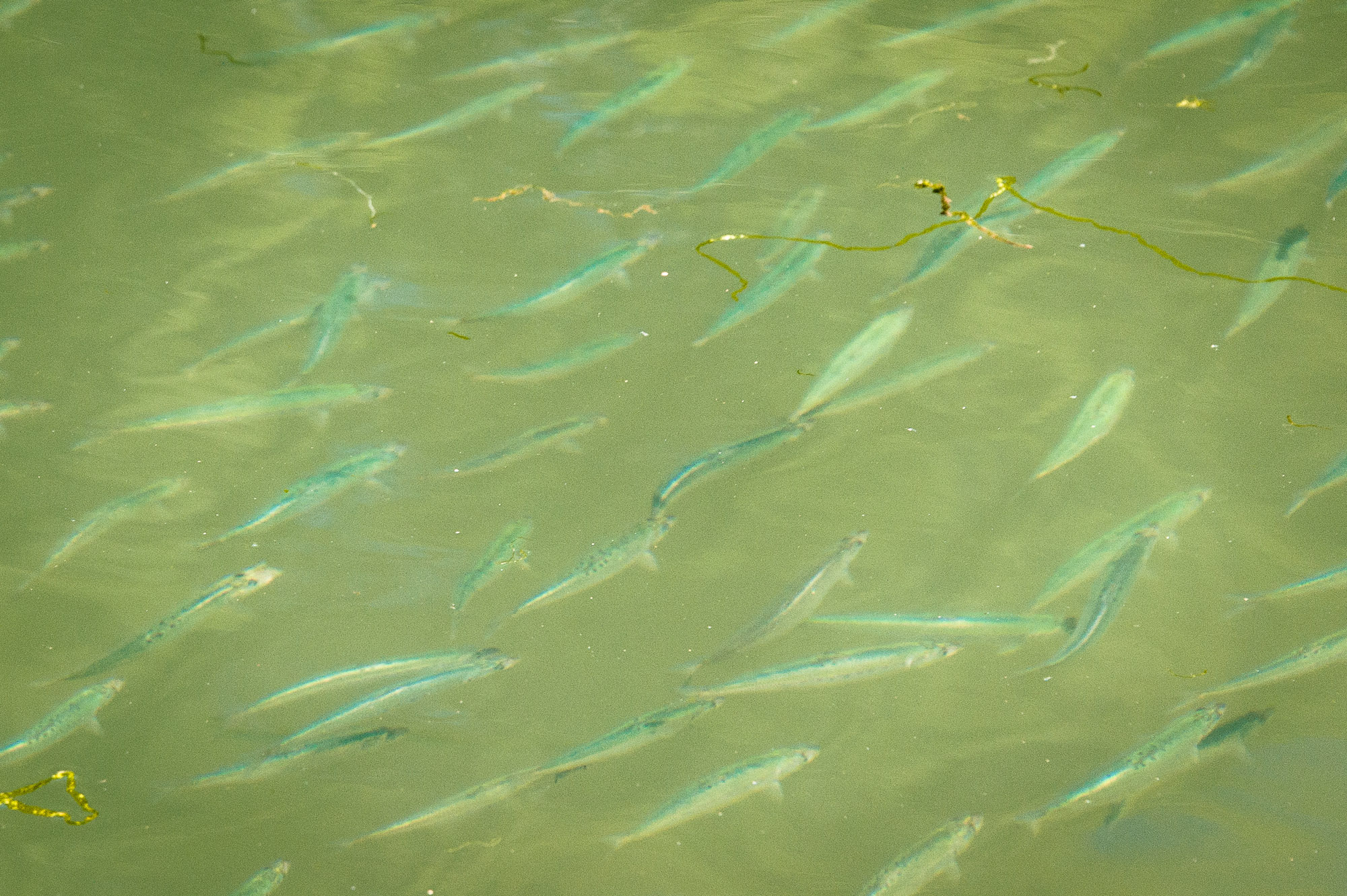 Herring swimming through the
Herring swimming through the
wild tidewaters of the Olympic Peninsula.
Photo © Carol Ann Morris
Carol and I cast, uncertain what to expect, and I hooked the unexpected: a small mackerel. Perhaps ten inches long it smacked my Morris Minnow, darted and fought and was finally ready to look absurdly small in Jim's big net, but I avoided the awkwardness of an absurd fish-to-net ratio by waiting for Carol to get her camera going so she could photograph my first mackerel on a fly, and the fish came off. Over the next 40 minutes we got chases from mackerel to our flies, but none would get itself hooked.
Predator
In a broad hole that formed suddenly in a dense herring school, a big salmon in its feeding prime of life swung through. Carol and I jumped to drop a fly near him but he was gone as suddenly as he had appeared. All those herring—it made perfect sense for a salmon to work the school. We saw no others, though. However, there must be times when a gang of salmon moves in to slash at those vast schools. No river salmon I've ever hooked fought with anything like the wild vigor of a sea-feeding salmon not yet mellowed by any stage of the spawning process. I've put it on my wish list: Fish Jim's estuary when the salmon are in for the herring schools.
A Lake Angler's Approach to Pickled Species
All those herring—miniature cousins of the man-size tarpon of fishing legend. . . I had to try to catch a few. (Herring, not tarpon, that is. The water's a tad. . .cool. . .around here for tarpon.) The fish were mostly darting and gliding on a plane about two feet down. The situation reminded me vaguely of trout feeding on Chironomid pupae in a lake, the fish all working at about the same level. So, without any more to go on than that I tied on a dry fly as an indicator, tied some tippet off the bend, and asked Carol if she had a trout-lake Chironomid-fly in any of her fly boxes. She had one suitable brown Gummy Worm (one of my patterns) and I tied it to the tippet, threw the rig out there.
Nothing happened after a minute, even with the fly down among the close grey bodies of herring, so I gave the dry fly a tug. It darted back. I struck. Something struggled, then came off. So I tossed and tugged again and hooked another one.
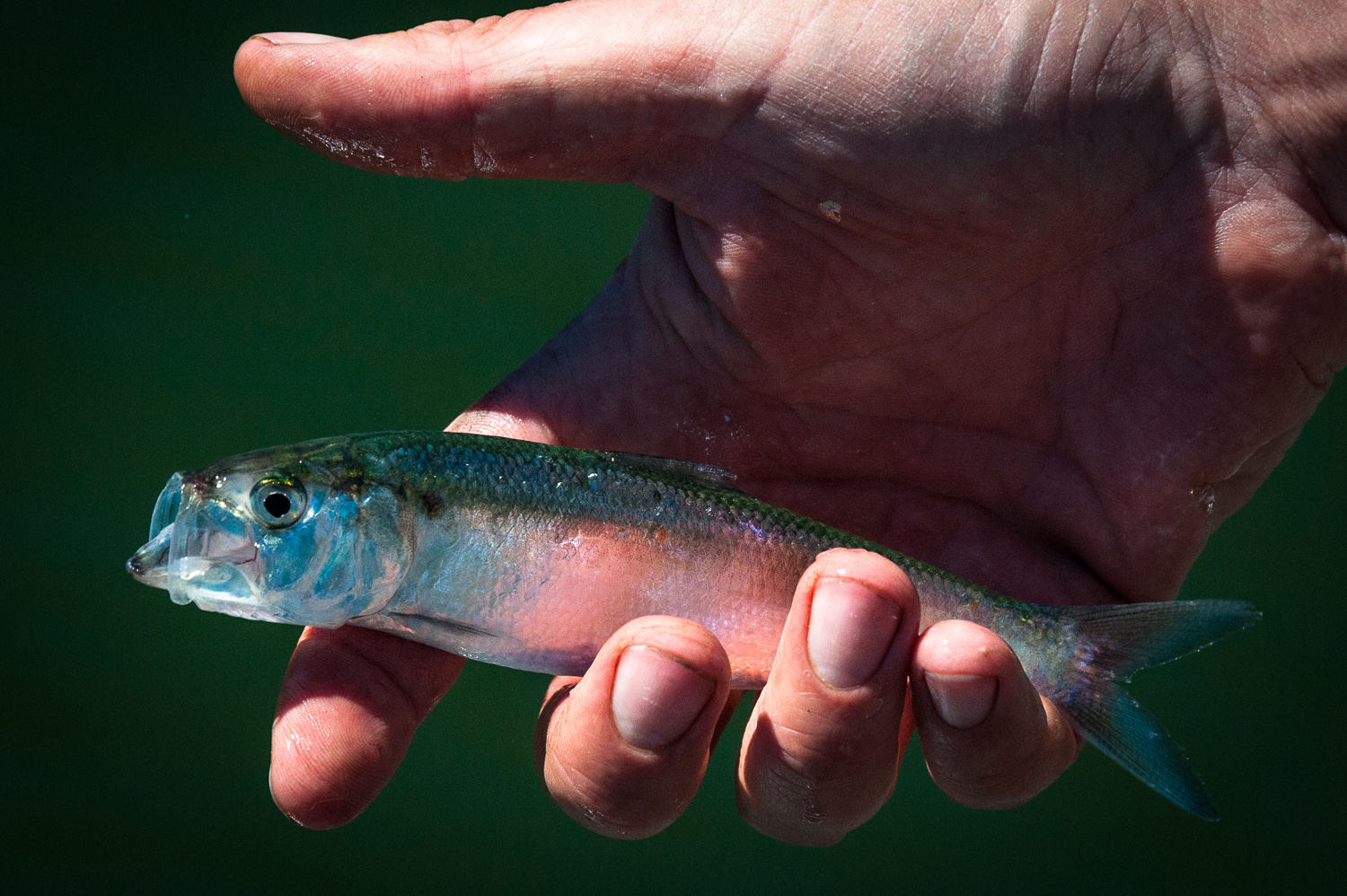 A bright herring caught on a
A bright herring caught on a
chironomid imitation in western Washington's rivers.
Photo © Carol Ann Morris
Fifteen minutes later I'd lost a bunch of herring but had landed six or eight of around seven inches long. My first herring on a fly. . .I wasn't sure whether to be proud or alarmed. I was sure, however, that I felt delighted to catch a new species.
Jim laughed. "That's one reason I always like fishing with you, Skip—I mean, how many fly fishers would get excited about Chironomid fishing for herring?"
Right. . . Probably not many. But, after all, how many can say they've caught herring on a fly? I now belong to that select group who can.
In Retrospect
At the end of our two fishing days with Jim, it seemed clear that his Summer Fishing would make some modest demands on his clients—casting mainly: fairly long casts were often required. This suggests to me a modicum of casting experience; a two-season fly fisher who's spent some casting-practice time on the lawn should be capable of the 50- to 60-foot casts we often made. A first-season fly fisher who's packed in considerable practice time could probably do the same.
Clearly, this is not expert-level fishing either. Not at all. But neither is it newbie-level fishing, fishing for someone who barely knows what it feels to pick up a fly rod.
What it definitely is, however, is fascinating fishing that will inhabit my daydreams until I return to it.
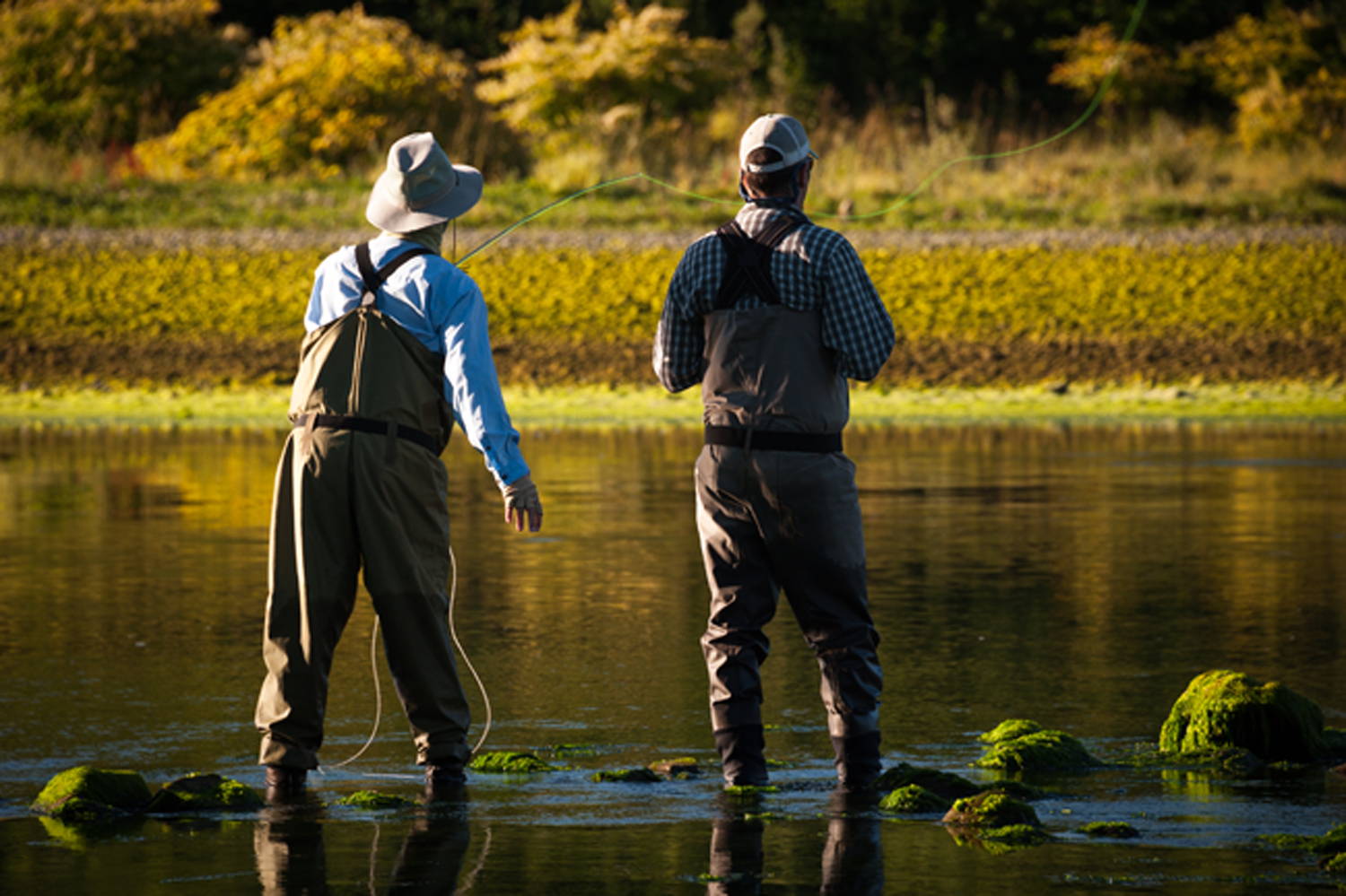 Skip casting into a tidewater pool hoping for
Skip casting into a tidewater pool hoping for
a sea-run cutthroat (with guide Jim Kerr).
Photo © Carol Ann Morris
Click here to hear Skip's interviews on popular podcasts...
*Announcements*
Skip has an essay in Big Sky Journal's annual Fly Fishing issue, called "Montana Hoppers: the Princess and the Brute" released February 1, 2023. Skip rewrote it a bit; I painted and illustrated it here, on our website. Here's the link on our web page to check it out:
Click here to read Skip's essay Montana Hoppers: The Princess and the Brute...
Skip's latest books:
Top 12 Dry Flies for Trout Streams: How, When, and Where to Fish Them, is now available on Amazon as an ebook...check it out! Click on the links below to go to the information page on Top 12 Dry Flies (the link to Amazon is at the bottom of the page...)
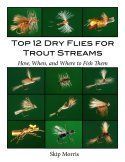 Top 12 Dry Flies for Trout Streams: How, When, and Where to Fish Them
Top 12 Dry Flies for Trout Streams: How, When, and Where to Fish Them
Click here to get more information about
Top 12 Dry Flies for Trout Streams: How, When, and Where to Fish Them (the link to Amazon is at the bottom of the page)...
Top 12 Dry Flies for Trout Streams: How, When, and Where to Fish Them (the link to Amazon is at the bottom of the page)...
Top 12 Nymphs for Trout Streams: How, When, and Where to Fish Them, 2nd Edition, originally published as an e-book only, is now available on Amazon as a paperback...check it out! Click on the links below to go to the information page on Top 12 Nymphs (the link to Amazon is at the bottom of the page...)
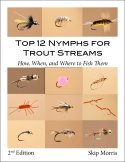 Top 12 Nymphs for Trout Streams: How, When, and Where to Fish Them (2nd Edition)
Top 12 Nymphs for Trout Streams: How, When, and Where to Fish Them (2nd Edition)
Click here to get more information about
Top 12 Nymphs for Trout Streams: How, When, and Where to Fish Them (2nd Edition). . .
Top 12 Nymphs for Trout Streams: How, When, and Where to Fish Them (2nd Edition). . .
Click here to get more information about Skip's e-book,
500 Trout Streams...
500 Trout Streams...
Skip's latest paperback book:
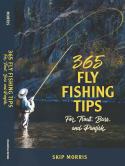 365 Fly Fishing Tips for Trout, Bass, and Panfish
365 Fly Fishing Tips for Trout, Bass, and Panfish
Click here to get more information about Skip's latest book,
365 Tips for Trout, Bass, and Panfish...
365 Tips for Trout, Bass, and Panfish...
Print Skip's chart for FREE:
Skip Morris's Trout-Fly Proportion Chart
Go to Skip Morris's Trout Fly Proportion Chart
Skip's Predator is available to buy...
Skip's ultra-popular Predator—a hit fly for bluegills and other panfishes and largemouth bass (also catches smallmouth bass and trout)—is being tied commercially by the Solitude Fly Company.
The Predator
CLICK HERE to learn more about or to purchase the Predator...
Learn to Tie Skip's Predator
Do you want to tie the Predator?
Tying the Predator
Skip shows you how to tie it on his YouTube Channel link, listed below:
CLICK HERE to see Skip's detailed video on how to tie the Predator...



